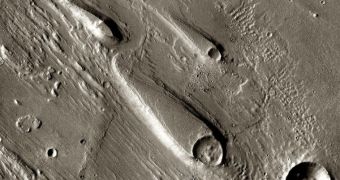If the Mars Odyssey orbiter NASA operated around the Red Planet manages to survive until next week – and there are absolutely no reasons to believe that it will not – the spacecraft will become the most extensive mission carried out around our neighboring planet.
The record is currently held by the NASA Mars Global Surveyor probe, which orbited the planet between September 11, 1997 and November 2, 2006. Its record will be exceed on December 15.
MGO spent 3,340 days around Mars, and Odyssey will exceed that number next Wednesday. It arrived at the planet and achieved orbital insertion on October 24, 2001, after launching on April 7, 2001.
The take off was handled by a Delta II delivery system, which launched from the Cape Canaveral Air Force Station (CCAFS), in Florida. The facility is located right next to the Kennedy Space Center.
In the first few months of mission, the orbiter made the most important discovery of its mission. It managed to confirm that vast amounts of water exist as ices at the Martian poles, buried beneath thin layers of red dust.
By the end of its primary mission, in late 2004, the spacecraft had also finished conducting radiation-safety checks for the entire planet. This was done so that NASA mission planners could develop safe manned missions to Mars.
The past six years of mission have been focused on conducting large-scale studies of various features and regions of the planet, and also on facilitating the contact of Martian rovers and landers with Earth.
“The extra years have allowed us to build up the highest-resolution maps covering virtually the entire planet,” explains expert Jeffrey Plaut, who is based at the NASA Jet Propulsion Laboratory (JPL), in Pasadena, California.
Plaut holds an appointment as an Odyssey project scientist at the lab. He adds that most of the maps were obtained with the Thermal Emission Imaging System (THEMIS) camera on the probe.
The instrument is designed, built, and operated by scientists at the Arizona State University (ASU), in Tempe. Its contributions to our understanding of Mars have been invaluable to science.
One of the most important achievements of the extended mission was that climate scientists were able to monitor seasonal changes on the planet, such as for example how carbon dioxide moves through the Martian atmosphere from season to season.
“It is remarkable how consistent the patterns have been from year to year, and that's a comparison that wouldn't have been possible without our mission extensions,” Plaut concludes.

 14 DAY TRIAL //
14 DAY TRIAL //